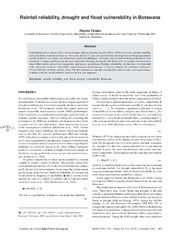| dc.contributor.author | Tsheko, Rejoice | |
| dc.date.accessioned | 2024-11-14T12:48:17Z | |
| dc.date.available | 2024-11-14T12:48:17Z | |
| dc.date.issued | 2004-08-04 | |
| dc.identifier.citation | Tsheko, R. (2003). Rainfall reliability, drought and flood vulnerability in Botswana. Water Sa, 29(4), 389-392. | en_US |
| dc.identifier.issn | 1816-7950 | |
| dc.identifier.uri | https://www.ajol.info/index.php/wsa/article/view/5043 | |
| dc.identifier.uri | https://hdl.handle.net/13049/767 | |
| dc.description | Journal article | en_US |
| dc.description.abstract | Rainfall data from 14 stations (cities, towns and major villages) spanning 26 years (1970 to 1995) were used to calculate reliability and vulnerability of rainfall in Botswana. Time series data for 72 years were generated from the long-term rainfall gauging stations and the number of wet and dry years determined. Apart from Mahalapye, most places have rainfall reliability greater than 0.5 but less than 0.7. Palapye and Serowe are the most vulnerable to flooding. During the 1995 floods, 87% of casualties were from these areas. Other factors such as rivers, topography, land use etc. can influence flooding vulnerability, but these have not been dealt with in the study, and hence vulnerability is purely based on rainfall amounts. Using two methods, the correlation coefficient is 0.9 (p<0.005) for reliability and risk values. The first method was originally developed for water resource system performance evaluation and the second method is based on dry/wet year sequences. | en_US |
| dc.language.iso | en | en_US |
| dc.publisher | Water SA | en_US |
| dc.relation.ispartofseries | Water SA;Vol. 29 No. 4 (2003) | |
| dc.subject | Rainfall Reliability | en_US |
| dc.subject | Risk Drought | en_US |
| dc.subject | Vulnerability Flood | en_US |
| dc.subject | Botswana | en_US |
| dc.title | Rainfall reliability, drought and flood vulnerability in Botswana | en_US |
| dc.type | Article | en_US |

